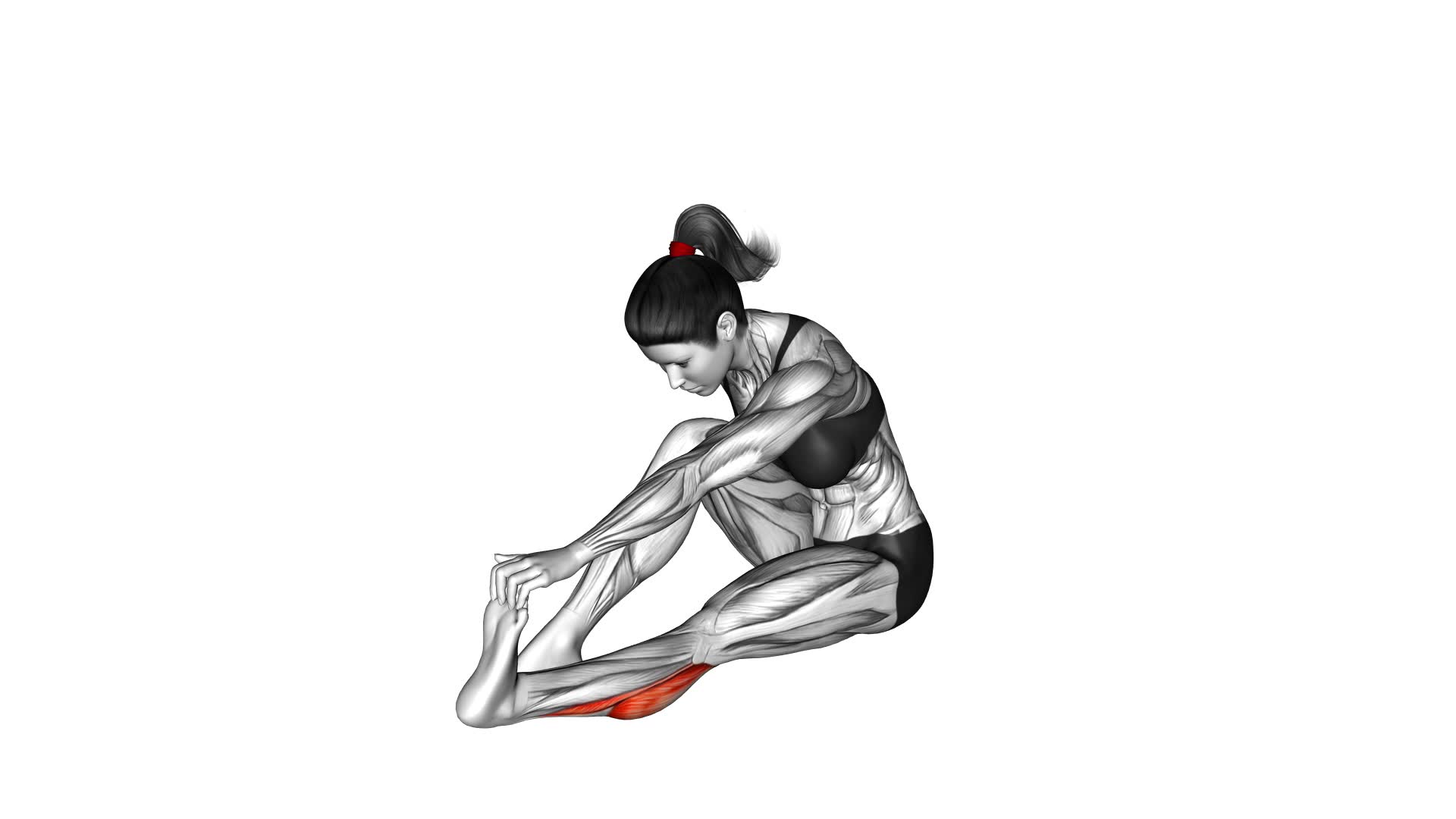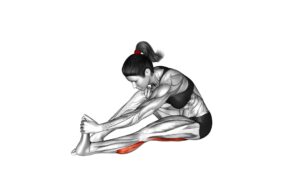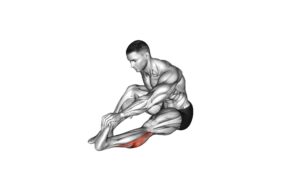Seated Calf Stretch (female) – Video Exercise Guide & Tips

Are you looking to improve the flexibility and strength of your calves? Look no further than the Seated Calf Stretch.
Watch This Exercise Video
In this video exercise guide, we will show you the proper form and technique to maximize your stretch. Whether you're a beginner or an advanced fitness enthusiast, we have modifications for all fitness levels.
Avoid common mistakes and get the most out of your stretch with our helpful tips.
Get ready to feel the burn and see results with this effective calf stretch.
Key Takeaways
- Seated Calf Stretch reduces the risk of strains and tears in calf muscles.
- Seated Calf Stretch targets gastrocnemius and soleus muscles for stability and power.
- Seated Calf Stretch improves range of motion in ankles for better movement.
- Seated Calf Stretch enhances overall athletic performance.
Benefits of the Seated Calf Stretch
You should regularly incorporate the seated calf stretch into your exercise routine to reap its numerous benefits.
This stretch isn't only effective in preventing injuries but also in improving flexibility. By stretching the calf muscles, you can reduce the risk of strains and tears, which are common in activities that involve running, jumping, or sudden changes in direction.
The seated calf stretch targets the muscles in the back of your lower legs, including the gastrocnemius and soleus muscles. These muscles play a crucial role in providing stability and power during movement. By keeping them flexible and supple, you can enhance your overall athletic performance and prevent potential injuries.
The seated calf stretch also helps to improve the range of motion in your ankles, which is important for activities such as squatting, lunging, and even walking. Incorporating this stretch into your routine won't only keep you injury-free but also allow you to move more efficiently and effectively in your daily activities and workouts.
Proper Form and Technique
To ensure proper form and technique during the seated calf stretch, focus on maintaining a straight back and engaging the core muscles. This will help you maximize the benefits of the exercise and prevent injury.
One common misconception is that you need to forcefully push your knees down with your hands. However, this can strain your knees and isn't necessary for an effective stretch. Instead, simply relax your legs and allow gravity to gently pull your heels towards the floor. Keep your back straight, shoulders relaxed, and core engaged throughout the stretch.
There are also variations and progressions you can incorporate to challenge your calf muscles further. One variation is to perform the seated calf stretch with one leg at a time. Extend one leg while keeping the other bent, and focus on stretching the calf of the extended leg. You can also add resistance by placing a weight on the knees or using a resistance band around the balls of your feet. Gradually increase the weight or tension as your calf muscles become stronger.
Modifications for All Fitness Levels
To modify the seated calf stretch for all fitness levels, there are several options you can consider.
For those who find the standard seated calf stretch too easy, alternative exercises such as the standing calf stretch or the wall calf stretch can be tried. These exercises provide a different position for stretching the calf muscles, offering a different stimulus and potentially increasing the challenge.
To progress the seated calf stretch, resistance can be added. This can be done by using a resistance band or holding a dumbbell on your knee. The added resistance will put more stress on the calf muscles, helping to further strengthen and stretch them. Increasing the duration of the stretch or the number of repetitions can also be effective in challenging the calves.
Conversely, if the seated calf stretch is too difficult, the exercise can be regressed. Using a towel or yoga strap to assist with the stretch can provide additional support, making the exercise more manageable for individuals with limited flexibility or strength.
It's important to remember to listen to your body and work within your own limits. Modify the seated calf stretch as needed to suit your fitness level and gradually progress as you become stronger and more flexible.
Common Mistakes to Avoid
One common mistake to avoid when performing the seated calf stretch is neglecting proper form and technique. By ensuring you have the correct form, you can prevent injuries and improve flexibility effectively.
Here are some common mistakes to avoid:
- Rushing the stretch: It's crucial to take your time and perform the stretch slowly and controlled. Rushing through the movement can lead to ineffective stretching and increase the risk of injury.
- Using too much force: Applying excessive force during the stretch can strain your calf muscles and potentially cause harm. Instead, focus on a gentle and gradual stretch to avoid overstretching.
- Neglecting the alignment: Proper alignment is essential for an effective stretch. Ensure that your knees are bent at a 90-degree angle and your feet are flat on the ground. This alignment helps target the calf muscles and prevents unnecessary strain on other parts of the body.
Tips for Maximizing Your Stretch
To maximize your seated calf stretch, focus on maintaining proper form and technique while incorporating these helpful tips.
First, make sure to warm up your muscles before starting any stretching routines. This will help increase blood flow and prepare your muscles for a deeper stretch.
Additionally, try to relax your mind and body, as tension can limit your flexibility. Take slow, deep breaths throughout the stretch to help release any tension and allow for a greater range of motion.
It's also important to be consistent with your stretching routine. Stretching regularly will gradually increase your flexibility over time.
Lastly, listen to your body and avoid pushing yourself too hard. Stretching shouldn't be painful, so if you feel any discomfort, ease off the stretch. Remember, the goal is to gradually improve your flexibility, not to force it.
Frequently Asked Questions
How Often Should I Perform the Seated Calf Stretch?
To get the most benefits from the seated calf stretch, it's important to consider the frequency of your workouts. How often should you perform this exercise?
The answer depends on your fitness level and goals. Generally, it's recommended to do the seated calf stretch at least 2-3 times a week. This will help improve flexibility, reduce muscle tightness, and prevent injuries.
Remember to listen to your body and adjust the frequency accordingly.
Can the Seated Calf Stretch Help With Plantar Fasciitis?
The seated calf stretch can be beneficial for plantar fasciitis. By stretching the calf muscles, it helps alleviate tension on the plantar fascia, reducing pain and discomfort.
Additionally, incorporating modifications like using a towel or a resistance band can increase the effectiveness of the stretch.
Furthermore, the seated calf stretch improves overall flexibility, which can aid in preventing injuries and promoting better movement.
Is It Necessary to Warm up Before Doing the Seated Calf Stretch?
Before doing the seated calf stretch, it's important to warm up. Warming up helps prepare your muscles for exercise and reduces the risk of injury.
Stretching before exercise has many benefits, such as increasing flexibility and improving performance.
The seated calf stretch has different variations that target different parts of the calf muscles.
It's recommended to start with a lighter stretch and gradually increase the intensity as your muscles warm up.
Can I Do the Seated Calf Stretch if I Have a Calf Injury?
If you have a calf injury, it's important to take extra precautions when performing the seated calf stretch. Consult with a healthcare professional or physical therapist to determine the best modifications for your specific injury.
They may recommend alternative exercises or modifications to the seated calf stretch that will allow you to still work on stretching and strengthening your calf muscles without exacerbating your injury.
Always prioritize your safety and listen to your body.
Are There Any Alternative Stretches That Can Target the Same Muscles as the Seated Calf Stretch?
There are alternative stretches that can target the same muscles as the seated calf stretch. These stretches focus on the calf muscles and can provide similar benefits. Some options include standing calf raises, wall calf stretches, and single-leg calf raises.
These exercises engage the calf muscles and help improve flexibility and strength. Incorporating these alternatives into your routine can help you achieve the desired muscle targeting and enhance your overall calf workout.
Conclusion
Incorporating the seated calf stretch into your exercise routine can provide numerous benefits, including improved flexibility and range of motion in the calves. By following the proper form and technique, you can ensure that you're getting the most out of this stretch.
Remember to make modifications as needed to accommodate your fitness level and avoid common mistakes. By maximizing your stretch and consistently incorporating it into your routine, you can help prevent injuries and improve your overall calf strength and mobility.

Author
Years ago, the spark of my life’s passion ignited in my mind the moment I stepped into the local gym for the first time. The inaugural bead of perspiration, the initial endeavor, the very first surge of endorphins, and a sense of pride that washed over me post-workout marked the beginning of my deep-seated interest in strength sports, fitness, and sports nutrition. This very curiosity blossomed rapidly into a profound fascination, propelling me to earn a Master’s degree in Physical Education from the Academy of Physical Education in Krakow, followed by a Sports Manager diploma from the Jagiellonian University. My journey of growth led me to gain more specialized qualifications, such as being a certified personal trainer with a focus on sports dietetics, a lifeguard, and an instructor for wellness and corrective gymnastics. Theoretical knowledge paired seamlessly with practical experience, reinforcing my belief that the transformation of individuals under my guidance was also a reflection of my personal growth. This belief holds true even today. Each day, I strive to push the boundaries and explore new realms. These realms gently elevate me to greater heights. The unique combination of passion for my field and the continuous quest for growth fuels my drive to break new ground.







